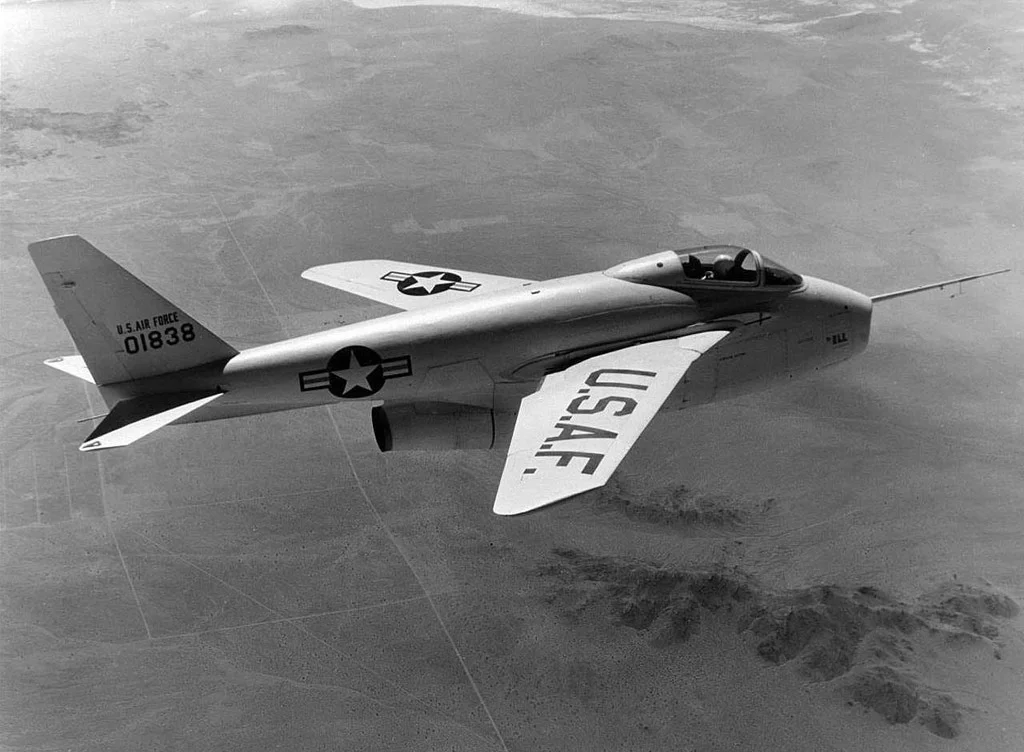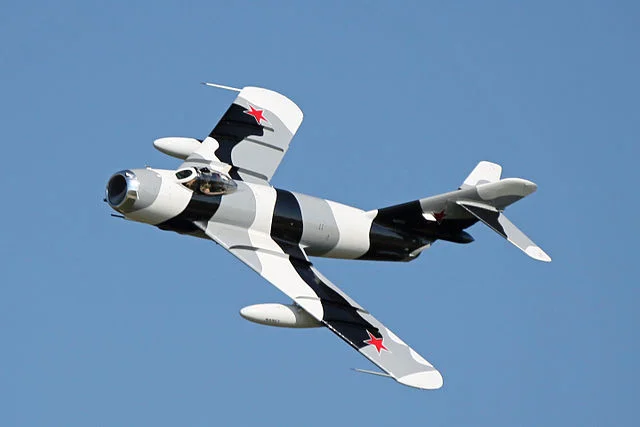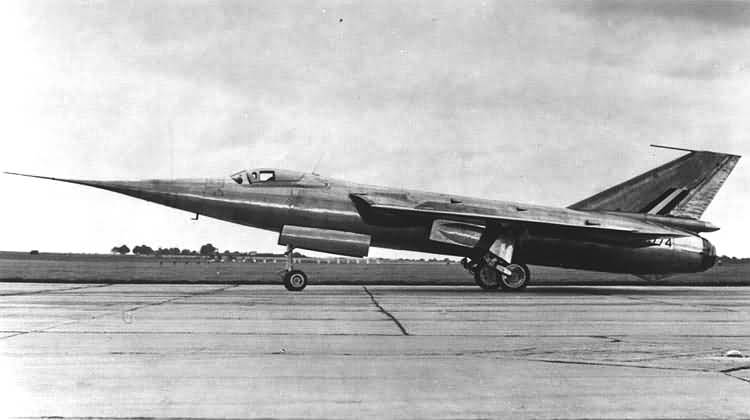The Vought F-8 Crusader, a symbol of air superiority during the Cold War era, is a carrier-based aircraft, that played a pivotal role in projecting the power of the US Navy around the globe. First taking to the skies in 1955, this impressive aircraft was in service with the French Navy all the way until 1999.
Contents
Development and Production
In the early 1950s, the burgeoning Cold War tensions underscored the urgent need for the United States Navy to possess an advanced, carrier-based fighter capable of securing air superiority. The Soviet Union’s progress in jet technology acted as a catalyst, propelling the United States to seek a revolutionary aircraft that would ensure dominance in the skies.
Read More The Photoflash Bombs that Illuminated Cities
Responding to this challenge, the Chance Vought Corporation, leveraging its extensive experience in military aircraft design, embarked on the ambitious project to create the F-8 Crusader. The design objectives were clear: develop a supersonic jet fighter that excelled in speed, manoeuvrability, and firepower. The engineering team, led by the visionary John Russell Clark, embarked on this daunting task.

One of the project’s groundbreaking features was the decision to incorporate a variable-incidence wing into the aircraft’s design. This innovation allowed the wing’s angle of attack to be adjusted without altering the fuselage’s orientation, significantly enhancing the aircraft’s carrier landing capabilities. Such a feature was critical for operations in the confined spaces of aircraft carriers, providing pilots with improved visibility and control during the critical phases of takeoff and landing.
The propulsion system of the Crusader broke new ground with the integration of the Pratt & Whitney J57 turbojet engine. This powerhouse engine enabled the aircraft to breach the sound barrier with ease, achieving speeds in excess of 1,000 mph. The J57 engine’s reliability and performance played a crucial role in cementing the F-8’s reputation as a formidable air combat contender.
As the development process advanced, rigorous testing phases underscored the aircraft’s potential. The first flight of the F-8 Crusader, on 25 March 1955, heralded a new chapter in naval aviation. The aircraft’s performance during these tests exceeded expectations, showcasing its superior speed, agility, and combat capabilities.
The production of the Crusader saw over 1,200 units being built, reflecting its widespread acceptance and critical role in the United States Navy’s strategic arsenal. The aircraft underwent several modifications and upgrades throughout its service life, adapting to evolving combat requirements and technological advancements. Variants such as the F-8E introduced enhanced radar systems, improved engines, and greater weapon load capacity, further extending the Crusader’s operational versatility.
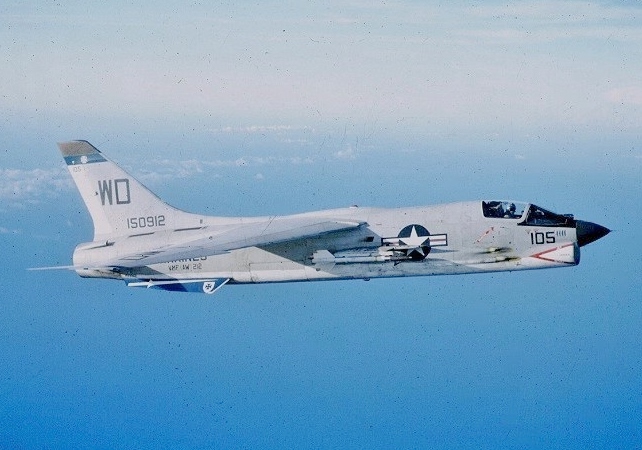
Variable-incidence Wing
The variable-incidence wing of the Vought F-8 Crusader stands out as one of the most innovative and distinguishing features in the aircraft’s design, embodying a leap forward in aviation technology. This design choice directly addressed the inherent challenges associated with operating high-performance jet fighters from the decks of aircraft carriers. The primary function of the variable-incidence wing was to improve the aircraft’s takeoff and landing capabilities, crucial for safe and efficient carrier operations.
Read More Breguet 460 Vultur Interwar Bomber
Engineers at Vought incorporated this unique feature, allowing the pilot to adjust the angle of the wing’s incidence—that is, the angle between the wing chord line and the fuselage. During takeoff and landing, the pilot could raise the wing relative to the fuselage, increasing the wing’s angle of attack while keeping the fuselage relatively level. This innovation significantly enhanced the aircraft’s lift at lower speeds, which is paramount during the critical phases of carrier takeoffs and landings.
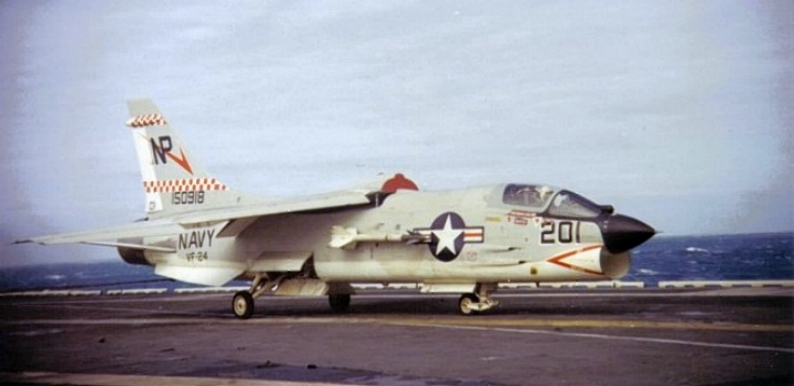
One of the key benefits of this mechanism was the improved pilot visibility during approach and landing. By maintaining a level fuselage, the pilot had a clearer view of the carrier deck, thus enhancing operational safety and precision during these high-risk manoeuvres. Moreover, the ability to increase lift without compromising visibility or requiring a high nose-up attitude was a remarkable achievement that set the Crusader apart from its contemporaries.
The variable-incidence wing also contributed to the Crusader’s superior aerodynamic performance across a wide range of speeds, particularly in dogfighting scenarios where manoeuvrability and the ability to quickly adjust flight parameters could determine the outcome of an engagement. By optimizing the lift-to-drag ratio, the Crusader could sustain tighter turns and more aggressive manoeuvres, providing a tactical advantage in air-to-air combat.
This feature was mechanically complex, and its successful integration into the Crusader’s design is a testament to the ingenuity and forward-thinking approach of its designers. The system involved a hydraulic actuator that could raise the wing up to seven degrees from its neutral position, with safety locks and indicators ensuring that the wing’s position could be securely controlled and monitored by the pilot.
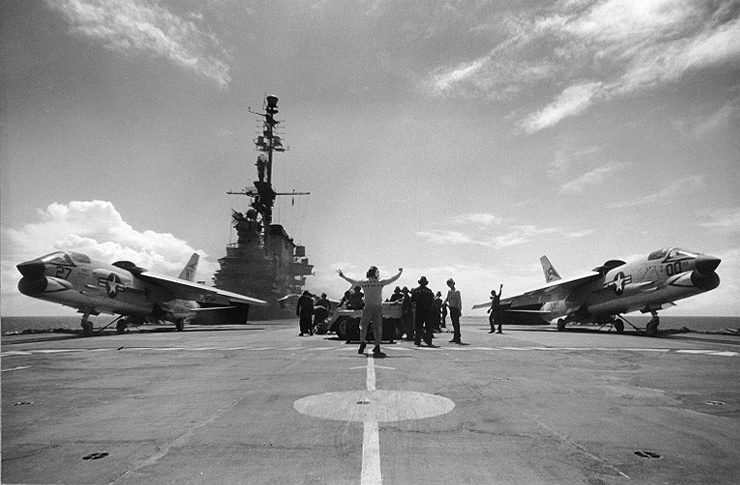
Despite the mechanical complexity and maintenance demands associated with the variable-incidence wing, its operational benefits in enhancing the Crusader’s performance and safety in carrier operations justified its inclusion. This innovative approach to solving the challenges of naval aviation left a lasting impact on aircraft design principles, highlighting the importance of adaptability and engineering ingenuity in overcoming operational constraints.
Operational History
Its introduction into service with the United States Navy in the late 1950s marked the beginning of a distinguished career that would see the Crusader becoming an icon of American air power.
Upon its deployment, the F-8 Crusader quickly distinguished itself as a superior air combat fighter, earning the nickname “The Last of the Gunfighters” due to its reliance on guns in an era increasingly dominated by missile technology. This reliance on traditional gunfighting, coupled with its advanced design features, made the Crusader a formidable opponent against any adversary.
Read More The Ju 86 could fly higher than 39,000 ft
The Vietnam War served as the proving ground for the F-8’s combat capabilities. As the conflict escalated, the Crusader was at the forefront of U.S. Navy operations, engaging in some of the earliest air-to-air battles of the war. Pilots valued the aircraft for its speed, agility, and, most importantly, its effectiveness in dogfights against North Vietnamese MiG fighters.
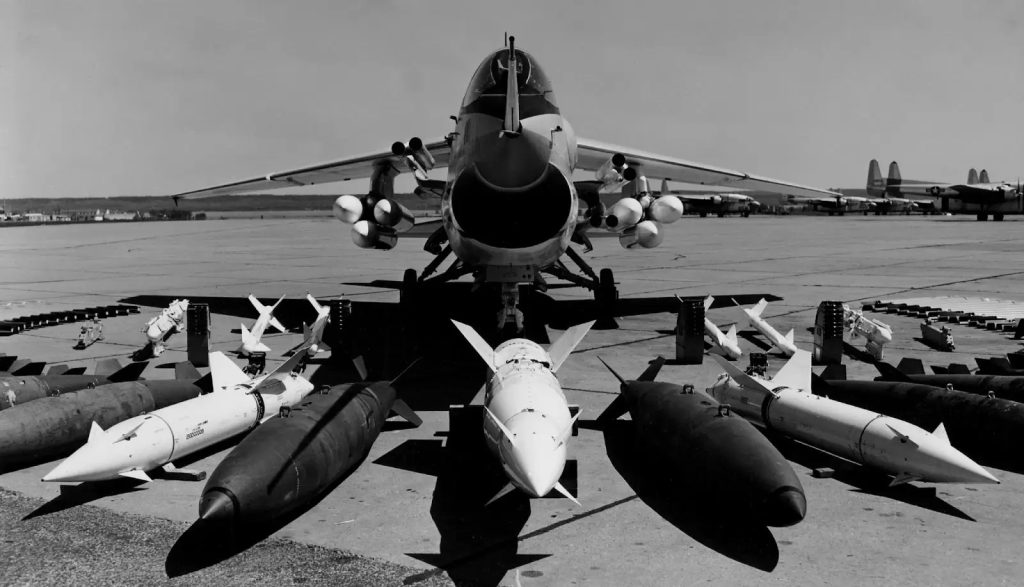
The Crusader’s ability to engage in close combat, utilising its cannons with lethal precision, allowed U.S. pilots to achieve numerous aerial victories. Notably, the Crusader accounted for the first U.S. air-to-air kill of the war and continued to amass an impressive combat record throughout the conflict.
Beyond its prowess in air-to-air combat, the F-8 Crusader also excelled in reconnaissance missions. Equipped with sophisticated cameras and sensors, reconnaissance variants of the Crusader undertook critical missions over enemy territory, gathering intelligence that proved invaluable for combat operations. The aircraft’s high-speed capabilities made it difficult for enemy anti-air defences to track and engage, allowing it to return safely from missions behind enemy lines.
The operational flexibility of the F-8 Crusader saw its service extend beyond the United States Navy. The French Navy adopted the Crusader for its aircraft carrier operations, where it served as a key component of France’s naval air arm into the 1990s. In this role, the Crusader conducted a range of missions, from air defence to reconnaissance, demonstrating its adaptability to various operational requirements.
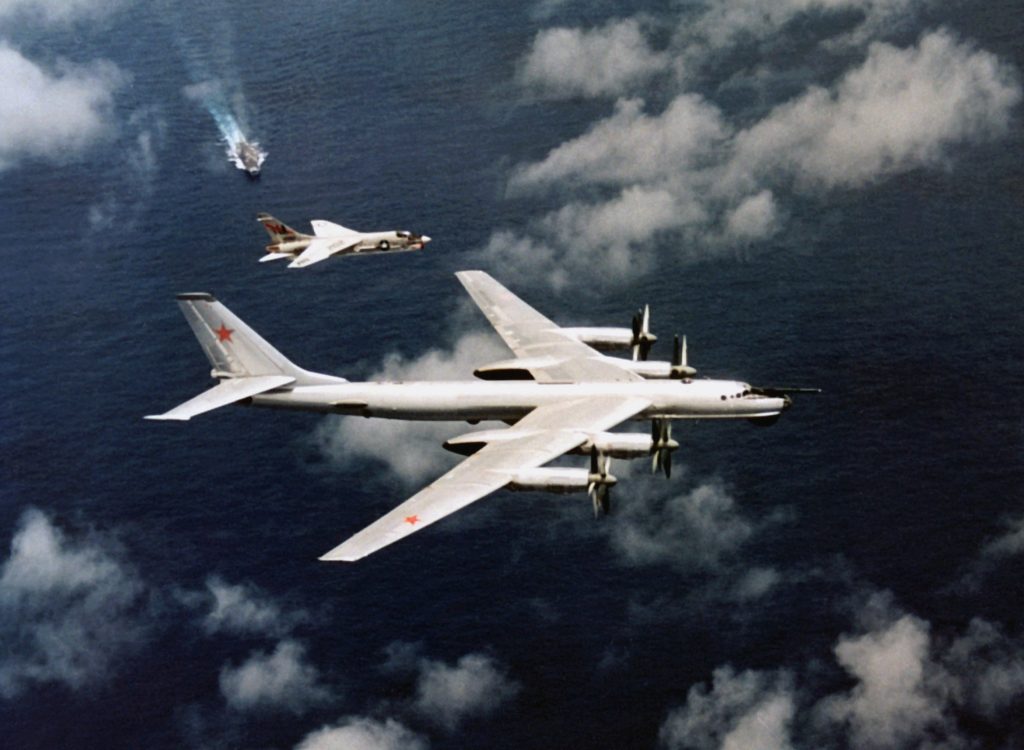
The Philippine Air Force also operated a number of F-8 Crusaders, further testament to the aircraft’s versatility and reliability. In the Philippines, the Crusader played a crucial role in national defence and air superiority missions, underscoring its global impact as a military aircraft.
Throughout its service life, the F-8 Crusader underwent continuous upgrades and modifications to enhance its combat effectiveness and operational capabilities. These improvements allowed the Crusader to remain a potent force in the face of evolving threats and changing warfare dynamics.
Variants
The initial production model, the F-8A (F8U-1), set the standard for subsequent variants. It featured the powerful Pratt & Whitney J57-P-4 engine, enabling supersonic speeds. The aircraft’s armament included four 20 mm Colt Mk 12 cannons, positioned under the intake, and it had the capacity to carry AIM-9 Sidewinder missiles. This variant laid the groundwork for future enhancements in firepower and performance.
Read More The P-51 Mustang Could Do it All
Following the F-8A, the F-8B (F8U-1B) introduced minor improvements, primarily in electronics and weapons systems, aimed at enhancing the aircraft’s air-to-air combat capabilities. This variant underscored the ongoing efforts to refine the Crusader’s combat effectiveness, particularly in engaging enemy aircraft.
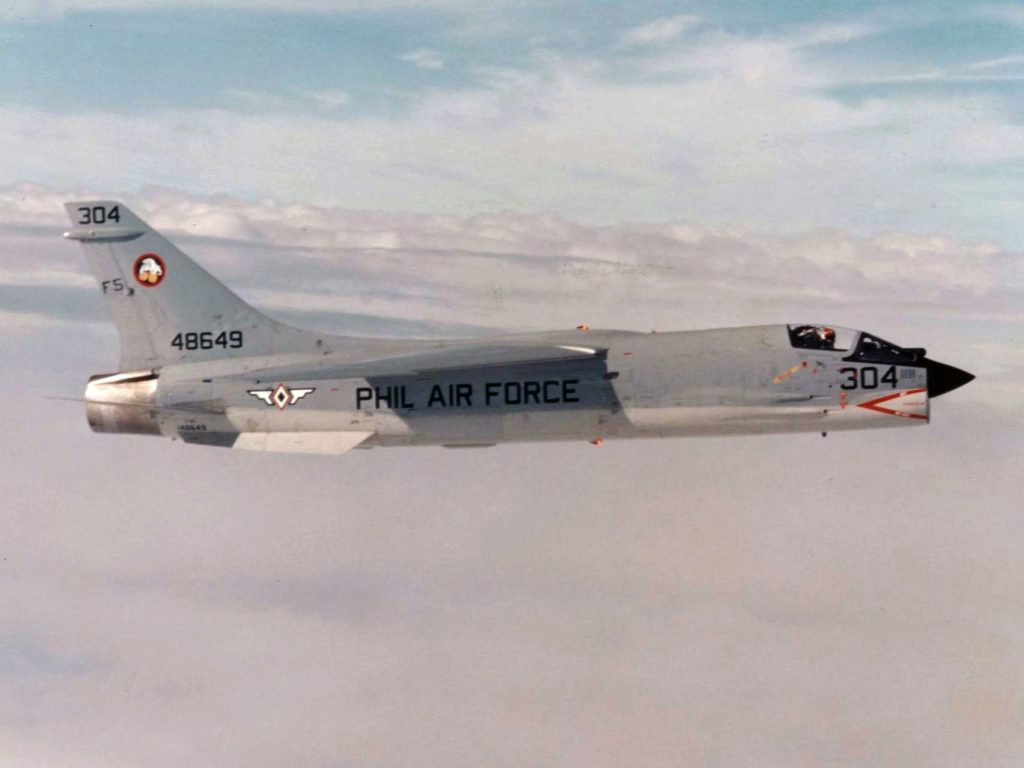
The F-8C (F8U-2) represented a significant upgrade over its predecessors. It incorporated a more powerful version of the J57 engine, the J57-P-16, which improved overall performance and thrust. Additionally, this variant featured an upgraded radar system, the AN/APQ-83, enhancing its targeting and engagement capabilities. The F-8C showcased the Crusader’s progression towards a more advanced fighter capable of tackling the challenges of modern aerial warfare.
One of the most notable variants, the F-8D (F8U-2N), introduced a major leap in electronic warfare capabilities. It was equipped with the AN/APQ-94 radar system, designed for all-weather operations, thereby expanding the Crusader’s operational envelope. The F-8D also saw the introduction of increased fuel capacity and the capability to carry additional armaments, including the AGM-12 Bullpup air-to-surface missile, broadening its role beyond pure air superiority missions.
The F-8E (F8U-2NE) further advanced the Crusader’s multirole capabilities. It featured an even more powerful radar, the AN/APQ-99, and improved navigation systems. This variant was capable of carrying a wider array of weapons, including the newer AIM-9C Sidewinder missile for air-to-air engagements and various air-to-ground munitions, making it a formidable platform for both air superiority and ground attack missions.
Other Operations
In addition to these fighter variants, the Crusader family also included reconnaissance versions, notably the RF-8A and RF-8G. These variants were stripped of their cannon armament to make room for cameras and sensors. They played a crucial role in photoreconnaissance missions, offering unparalleled speed and agility for overflight operations, and gathering vital intelligence in contested airspace without compromising on performance.
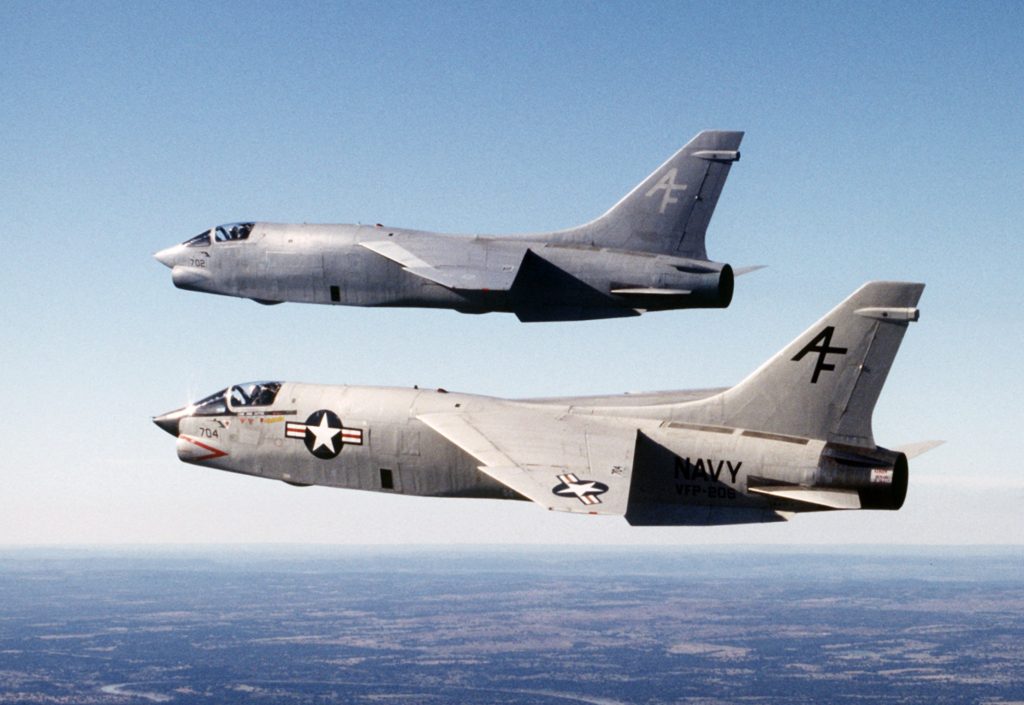
The F-8H, F-8J, F-8K, and F-8L variants represented incremental improvements, focusing on engine upgrades, avionics enhancements, and structural reinforcements to extend the aircraft’s service life and reliability. These later models ensured the Crusader remained competitive and capable, even as newer aircraft began to enter service.
Moreover, international variants, such as those operated by the French Navy, underscored the Crusader’s global appeal. The French models were adapted to meet specific requirements, such as compatibility with French aircraft carriers, demonstrating the Crusader’s international adaptability.
Read More Me 261, Informally Known as “Adolfine”
The Last True Gun Fighter?
The F-8 is often celebrated as the “Last of the Gunfighters,” a title reflecting its status as one of the final American fighter aircraft designed with guns as its primary armament. This moniker stems from a period of transition in aerial combat philosophy and technology, particularly during the late 1950s and early 1960s, when there was a shift towards missile-armed fighters.
During the era of the Crusader’s development and early service, military aviation was increasingly focusing on missile technology. The theory prevailing at the time suggested future air combat would be dominated by beyond-visual-range engagements, where pilots would rely on radar and missiles rather than traditional dogfighting skills and cannon armament. This shift led to the development of aircraft like the F-4 Phantom II, which initially lacked a gun in its original design, emphasising the role of missiles in air combat.
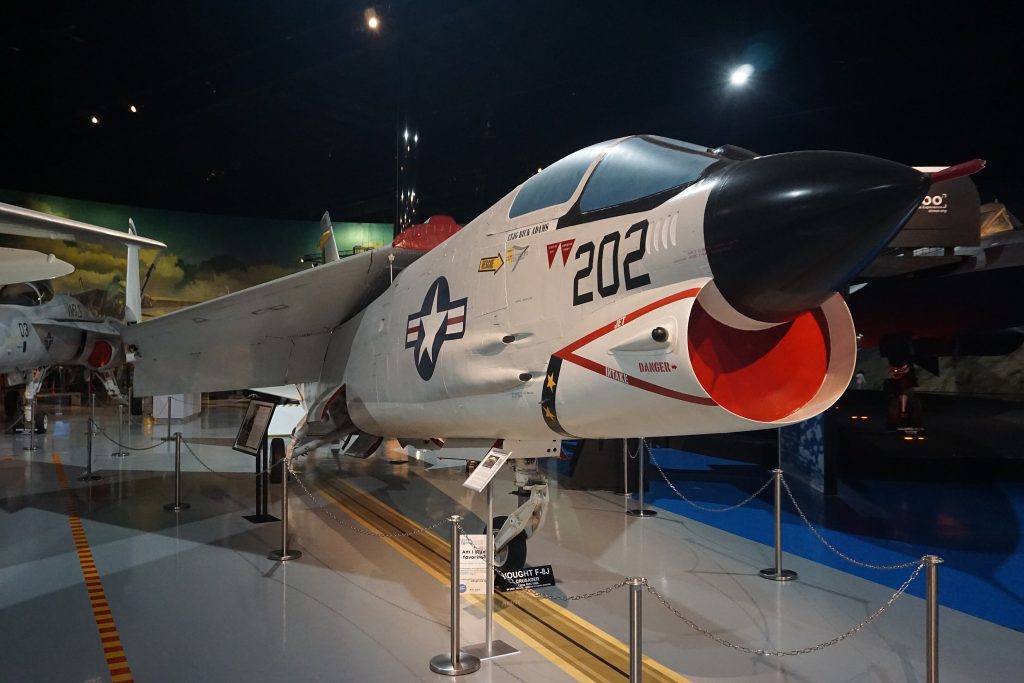
However, operational experience, particularly during the Vietnam War, challenged this missiles-only doctrine. Encounters between American and North Vietnamese aircraft highlighted the limitations of early air-to-air missiles, including issues with reliability, targeting, and rules of engagement requiring visual identification. These challenges underscored the continued importance of cannon armament for close-range engagements.
Deadly Firepower
The F-8 Crusader, with its four 20 mm Colt Mk 12 cannons, excelled in the traditional dogfighting role. Its design and tactics leveraged the pilot’s skill, the aircraft’s manoeuvrability, and the effectiveness of gun armament in visual range combat. The Crusader’s successes in air-to-air battles during the Vietnam War reinforced the value of guns in aerial combat and led to a reevaluation of the all-missile concept.
While the Crusader is often remembered as the last true gunfighter, it’s worth noting that the lessons learned from its service and the experiences in Vietnam influenced the integration of guns in subsequent fighter designs. The F-4 Phantom II, for example, was later fitted with a gun pod, and subsequent versions incorporated an internal gun, acknowledging the limitations of relying solely on missiles.
Moreover, modern fighter aircraft, despite their advanced missile systems, continue to be equipped with cannons for close-range engagements and strafing runs. This includes aircraft like the F-16 Fighting Falcon, F/A-18 Hornet, and the F-22 Raptor, all of which have internal guns as part of their armament.
Read More Lockheed Constellation World Class Icon in Aviation
While the F-8 Crusader may symbolize the end of an era where guns were the primary weapons of fighter aircraft, it also represents a bridge to modern air combat doctrines.




